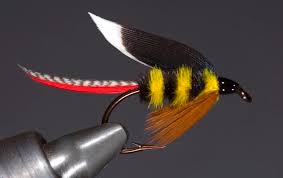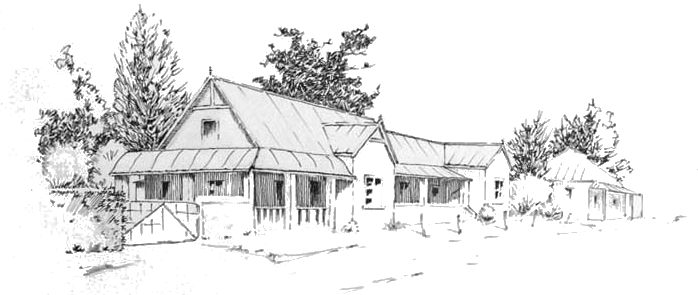In his book, Fly fishing in the Great Smoky Mountains National Park, which was published in 2010, Jim Casada says: “Without any question, the single most productive color when it comes to catching trout in the southern Appalachians is yellow.”

Does this have any relevance to small stream fly fishing in South Africa?
Not really, because the because the Smoky Mountain small streams contain brook trout, which are notoriously susceptible to fancy flies and South African streams contain rainbow and brown trout.

The native Brook trout native to the Smoky Mountains (Lisa Godfrey photo)
Here is what Gary LaFontaine said about yellow flies in The Dry Fly – New Angles (Greycliff Publishing Company. 1990)
“Yellow, like red, has other associations in a trout's mind that are as important as colour intensity. With bright yellow, however, it is a negative instead of a positive connection. In nature pure yellow, not some weaker off-shade, is a warning mechanism. No insect wears it to be subtle, since yellow is usually an intense colour.”
Martin Langlands, a New Zealand guide writes: “Well I remember in the 1970's watching a brown trout rising to dries from a high bridge. To my amazement I saw the trout rise and take a wasp. A few seconds later the trout resurfaced trying to dislodge the wasp from its mouth. STUNG!! So yellow does carry a warning relating to wasp and bee stings.”
Cape Town landing net maker Deon Stamer: “My wife and I were staying in a cottage on the farm Gevonden near Rawsonville. One afternoon we took a walk up the mountain along a little tributary. We found a lovely pool not two metres in diameter at which we stopped. The pool was full of little bass.
“Intrigued I started to find little insects to feed them. Ants, beetles and grasshoppers were the menu. The fish were taking them gratefully.
“Then I saw a hornet, with a yellow and black abdomen, struggling in the water in a run above the pool. I helped it out of the water and flicked it into my pet bass pond and here was the interesting thing. They dashed up to take it as with the other insects but then turned away. It was clear they wanted it but they seemed to recognize it as being dangerous.
“Eventually it was evident that they were trying to drown it. They would drag it under, shaking their heads and then letting it go. A fish then took it with purpose and swam away but clearly was stung because it stopped dead in its tracks and spat it out.
“Another fish dashed in and ate the hornet and that was that.
“It was quite clear that something about the hornet made them take it very gingerly. One wonders whether these fish had previously had an unpleasant experience with hornets or was it perhaps the colouring that made them wary. My guess is that colour plays a huge role in how a fish reacts to an insect and thus a fly.”
Peter Brigg: “I have, with interest, on more than one occasion, watched a wasp/hornet being washed down in the stream without any apparent interest by the trout. Perhaps this is because they have been stung before and somehow recognise the shape and colour – ‘once bitten (stung) twice shy’ as they say! On the other hand, watch a struggling hopper - even one with a yellow abdomen with black markings - and there is a pretty good chance it won't make it across the pool.
“Is it a matter of recognition built of familiarity? Shape plays a major role apart from other triggers in my view.”
LaFontaine goes on to buttress his concerns about yellow in trout fly patterns:
“In his book, ‘The Outside Story’, Robert Scammell writes about the McGinty:

A typical McGinty
‘Browns often take this imitation of bee and wasp as though they expect to be stung. Often the first suggestion that there is a fish anywhere in the vicinity is one jumping crazily with the McGinty in his soon to be bee-stung lips. Three times on a recent day browns that I know I had pricked on a previous cast came to and were hooked on a McGinty. It is unusual for a brown to come again immediately after feeling the hook in other flies; it almost seems as though they find nothing unusual in being stung by a fly
that looks like a bee.’
“It is not the bee itself that trout learn to recognize and avoid. After all, how many bees do trout see? Instead, it is the colour yellow (a bright shade) that conditions them to be cautious.
“This is not wild speculation. The same thing happens with a water boatman (yellow-bellied in our western species). This insect with a piercing tube gives a nasty sting. Only trout fourteen-inches or larger will feed on water boatmen on the upper Clark Fork. Apparently, smaller fish find the easy meal not worth the injury. Even big trout snatch the fly gingerly, often two or three times.
“The McGinty, with its bright stripes, epitomises both the problems and opportunities of yellow in a fly. It can pull strikes from even the most
sophisticated trout, but it also gets a lot of flashes and refusals. Many times, smaller fish avoid it entirely.
“Bill Seeples told me about an incident where he was underwater while two friends drifted yellow dry flies over a pool of rainbow trout. The fish looked like they were playing a game of dare, rushing up and bringing their lips as close as possible to the fly without touching it. Not one of the trout took the McGinty, but they kept the game going for almost ten minutes, some fish rising four or five times. They finally settled on the bottom and ignored all subsequent drifts.
“Trout do lose some of their wariness of yellow if there are consistent hatches of insects with bright yellow bodies. It helps if these insects are not poisonous and do not sting. The Yellow Sally stonefly (Isoperla species) and the Black Dancer caddisfly (Mystacides species) are two common and important trout stream hatches. When either one of these has been on the water for a few weeks the fish take not only specific imitations, but they rise better to intense yellow attractors, especially from 10 A.M. to 2 P.M.
“Still, bright yellow is a color to use very sparingly in flies. Even a McGinty fishes best on rainy days on canopy streams, a time apparently when trout expect odd terrestrials to be drowned and safe to eat. Better colours, or at least those acceptable to fish in more situations, are chartreuse (a sickly yellow- green color that doesn't spook timid feeders but still works as an attractor), or the pale yellow commonly seen in many insect bodies, including classic mayflies such as the Pale Morning Dun (Ephemerella inermis) and the Light Cahill (Stenonema species).”
Looking at the hoppers which I have come across on the streams near Cape Town and cross-referencing the information and the colour photographs in the Field Guide to Insects of South Africa (Struik, 2002) I would say that the most common are Rock Grasshoppers (Conistica saucia), Burrowing Grasshoppers (Acrotylus) and Yellow Wings (Oedaleus). If one takes the early instars into account I would say that two centimetres was an average length and tan the average colour.
So why then, did I choose yellow foam for my hopper pattern which is based on the McMurray Ant and which has proved very effective?

The author’s hopper pattern
The story is largely told by Tom Sutcliffe on this website:
http://www.tomsutcliffe.co.za/fly-fishing/fly-tying/item/211-tying-ed-herbsts-hopper.html
The heaviest parts of a hook are the eye and the hook bend and I reasoned that if I separated the two segments of foam (balsa wood on the McMurray Ant) and moved them fore and aft I would not only be providing buoyancy where it was most needed but I would be creating space in the middle of the fly to tie in the legs (the most important part of a hopper pattern) and the wing.
As Lefty Kreh and Gary Borger have pointed out it is the configuration and movement of the dangling legs that are the major trigger in these flies and I think that this is what made my hopper successful rather than the yellow foam which I first used.
This was in the early eighties and the foam I used came from a yellow camping mattress because that was the best material available to me at the time. I used a leather punch to create the body parts.
If were to tie the pattern now I would use white Rainy’s or Wapsi parachute posts coloured pale green or tan with a permanent marker or my favourite foam material, Larva Lace.



